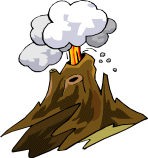
Volcanoes
 Large volcanoes can inject huge quantities of dust and other gaseous pollution into the air. The most explosive volcanic eruptions are able to send material many miles up into the atmosphere, above the level of most rain clouds. Here the pollution remains for up to two years, blown around the globe by winds.
Large volcanoes can inject huge quantities of dust and other gaseous pollution into the air. The most explosive volcanic eruptions are able to send material many miles up into the atmosphere, above the level of most rain clouds. Here the pollution remains for up to two years, blown around the globe by winds.
This volcanic pollution blocks out some of the sunlight. At the Earth's surface this causes a cooling of the climate. If the pollution spreads all around the Earth, a global cooling of as much as 0.3°C is possible which can last for 2 years. An example of this happened in 1991 when Mount Pinatubo in the Philippines erupted.
Websites
Other topics Technical Page
Technical Page
• Earth Science Explorer
• Introduction
• Atmosphere
• Causes
• Comets
• Continental Drift
• Earth's Orbit
• Global Warming
• Greenhouse Effect
• Ice Ages
• Mountains
• Oceans
• Sun
• Volcanoes
 Print Topic
Print Topic